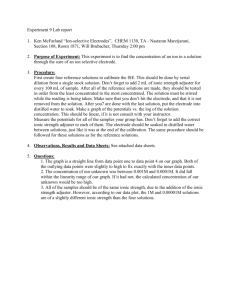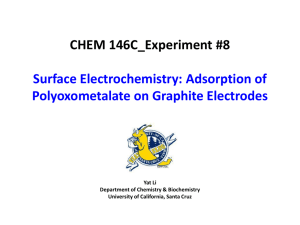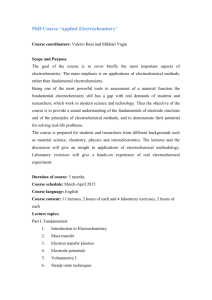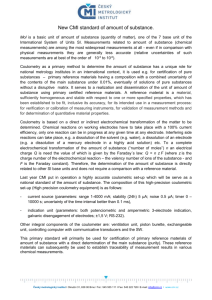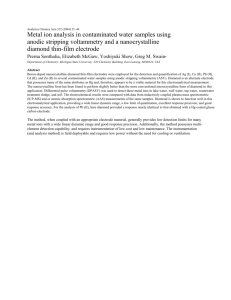Supporting Information - Springer Static Content Server
advertisement
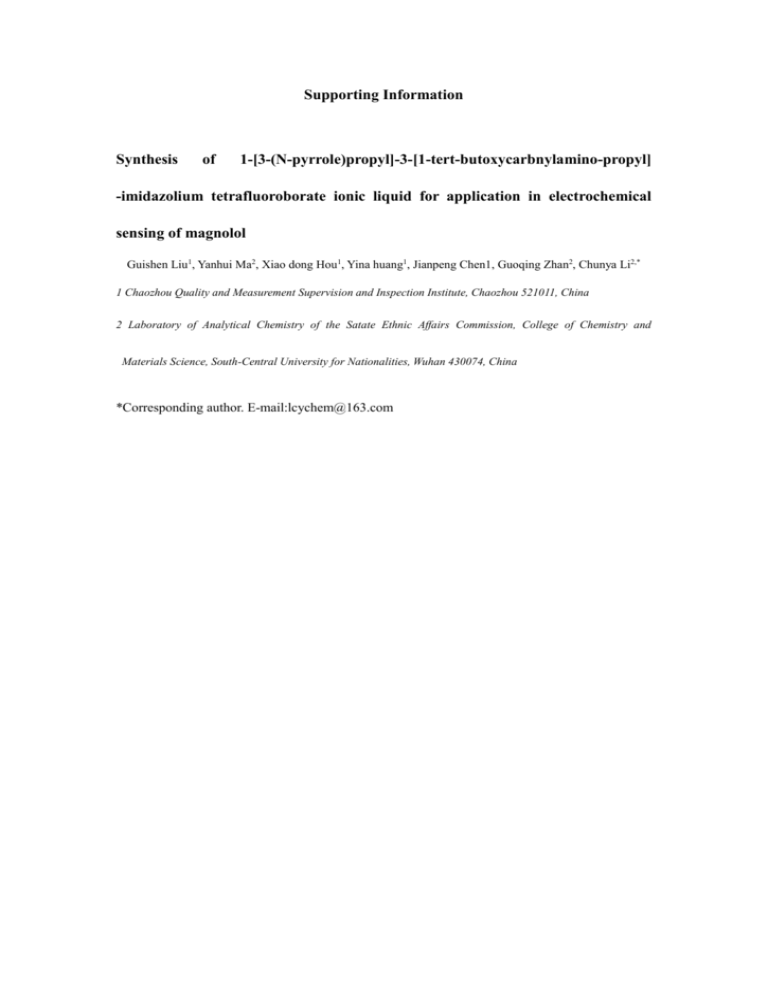
Supporting Information Synthesis of 1-[3-(N-pyrrole)propyl]-3-[1-tert-butoxycarbnylamino-propyl] -imidazolium tetrafluoroborate ionic liquid for application in electrochemical sensing of magnolol Guishen Liu1, Yanhui Ma2, Xiao dong Hou1, Yina huang1, Jianpeng Chen1, Guoqing Zhan2, Chunya Li2,* 1 Chaozhou Quality and Measurement Supervision and Inspection Institute, Chaozhou 521011, China 2 Laboratory of Analytical Chemistry of the Satate Ethnic Affairs Commission, College of Chemistry and Materials Science, South-Central University for Nationalities, Wuhan 430074, China *Corresponding author. E-mail:lcychem@163.com Table S 1 Comparison of analytical characteristics of the polymerized ionic liquid film electrode for magnonol determination with other electrochemical methods. Electrode Technique Conditions Linear range (μmol Polymerized 3-[1-butoxycarbnyl Differential pulse Phosphate buffer voltammetry pH 10.0 Differential pulse Phosphate buffer voltammetry pH 7.0 Differential pulse Phosphate buffer voltammetry pH 6.5 Differential pulse Phosphate buffer voltammetry pH 6.0 Differential pulse Phosphate buffer voltammetry pH 7.0 Reduced graphene oxide–wrapped WO3 Differential pulse Phosphate buffer nanowire modified glassy carbon electrode voltammetry pH 6.5 amino-propyl]-1-[3-(N-pyrrole)propyl]imidazoli L-1) 0.05 – 10.0 Detection limit (μmol Ref. L-1) 0.23 This method um tetrafluoroborate ionic liquid film electrode Mesoporous Al-dopedsilica modified electrode Mesoporous SiO2-modified carbon paste electrode Acetylene black nanoparticle-modified electrode Multiwalled carbon nanotubes modified glassy carbon electrode Multi-walled carbonnanotubes /poly(3,4-ethylenedioxythiophene) Linear sweep Phosphate buffer voltammetry 0.075 – 20.0 0.025 [1] 0.075 – 0. 75 0.038 [2] 0.038 – 0. 98 0.0188 [3] 0.019 – 3.76 0.00751 [4] 0.01 – 20.0 0.008 [5] 0.01 - 25 0.003 [6] pH 7.0 core-shell nanofibers References [1] Liu T, Zheng XJ, Huang W S, Wu K B (2008) Voltammetric detection of magnolol in Chinese medicine based on the enhancement effect of mesoporous Al/SiO2–modified electrode. Colloids and Surfaces B: Biointerfaces 65: 226 – 229. [2] Zhao J, Huang W S, Zheng X J (2009) Mesoporous silica-based electrochemical sensor for simultaneous determination of honokiol and magnolol. Journal of Applied Electrochemistry 39: 2415–2419. [3] Yang X F, Gao M M, Hu H D, Zhang H J (2011) Electrochemical detection of honokiol and magnolol in traditional Chinese medicines using acetylene black nanoparticle-modified electrode. Phytochemical Analysis 22: 291 – 295. [4] Huang W S, Gan T, Luo S J, Zhang S H (2013) Sensitive and selective electrochemical sensor for magnolol based on the enhancement effect of multiwalled carbon nanotubes. Ionics 19: 1303 – 1307. [5] Huang M, Wu Y, Hu W B (2014) A facile synthesis of reduced graphene oxide-wrapped WO3 nanowire composite and its enhanced electrochemical catalysis properties. Ceramics International 40: 7219 – 7225. [6] Zhang K X, Xu J K, Duan X M, Lu L M, Hu D F, Zhang L, Nie T, Brown K B (2014) Controllable synthesis of multi-walled carbonnanotubes /poly(3,4 -ethylenedioxythiophene) core-shell nanofiberswith enhanced electrocatalytic activity. Electrochimica Acta 137: 518 – 525. Scheme S 1. Synthetic route of 3-[1-butoxycarbnyl amino-propyl] -1-[3-(N -pyrrole)propyl]imidazolium tetrafluoroborate ionic liquid. NH2 O N + N O O O N N H N O Br N NaBF4 O N + N N BF4- N H O Scheme S 2 Mechanism for the polymerization of 1-[3-(N-pyrrole)propyl]-3-[1-tert-butoxycarbonylamino-propyl]imidazolium tetrafluoroborate ionic liquid. N -e-H+ * N R R *+ * N N N N R R R R + -e-H+ * N N N R R R + * N N (n-3) N N R R R R N N N R R R -e-H+ N N (n-2) N R R R O R= N + N BF4- N H O Scheme S 3. Mechanism for the oxidation of magnolol at the polymerized ionic liquid film electrode. O O OH -e-H+ OH OH OH O O O - -e -H+ O O O Coupling of free radicals Polymer It has been demonstrated that the electrochemical oxidation of phenolic compounds via one-electron or two-electron transfer would generate phenoxy radical, or phenoxonium ion and quinone, respectively [34-38]. It will be reasonable to deduce that the electrochemical oxidation mechanism for magnolol could be attributed to the aromatic-ring oxidation to form quinone and phenoxy radical. Subsequently, the generated radicals undergo chemical reactions or a free radical polymerization through C–O, C–C and/or O–O coupling. The resulting polymeric product of magnolol is a non-conducting film which will retard the mass and electron transfer of magnolol to the electrode surface. Fig. S 1 1H-NMR and 13C-NMR of 3-[1-butoxycarbnyl amino-propyl]-1-[3-(N -pyrrole)propyl]imidazolium tetrafluoroborate ionic liquid The inserted pictures are the assignments of 1H NMR and 13C NMR with the chemical structure. Fig. S 2 FTIR spectroscopy of 3-[1-butoxycarbnyl amino-propyl] -1-[3-(N -pyrrole)propyl]imidazolium tetrafluoroborate ionic liquid Fig. S3 Mass spectrum of 3-[1-butoxycarbnyl amino-propyl]-1-[3-(N -pyrrole)propyl]imidazolium cation. The m/z result indicates that the detected molecular weight of 3-[1-butoxycarbnyl amino-propyl]-1-[3-(N -pyrrole)propyl]imidazolium cation is 333.23186 which is consist with the theoretic molecular weight of this compound. Fig. S5 (a) Cyclic voltammograms of magnolol at the polymerized ionic liquid film electrode with different scan rate; (b) Relationship between the peak current and scan rate; (c) Relationship between peak potential and natural logarithm of scan rate. Fig. S 6 Differential pulse voltammograms of magnolol at the polymerized ionic liquid film electrode (e) and in the presence of ascorbic acid (a), catechol (b), dopamine (c) and uric acid (d). Fig. S 7 Differential pulse voltammogram for honokiol (a) and magnolol (b) at the polymerized ionic liquid film electrode. Fig. S 8 Differential pulse voltammograms of magnolol at different concentration. Fig. S 9 Calibration curve for magnolol determination at the polymerized ionic liquid film electrode. Fig. S 10 Differential pulse voltammograms of Magnolia officinalis sample (a) and addition of 0.2 µmol L-1 magnolol (b).
